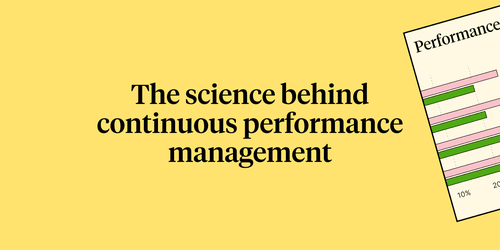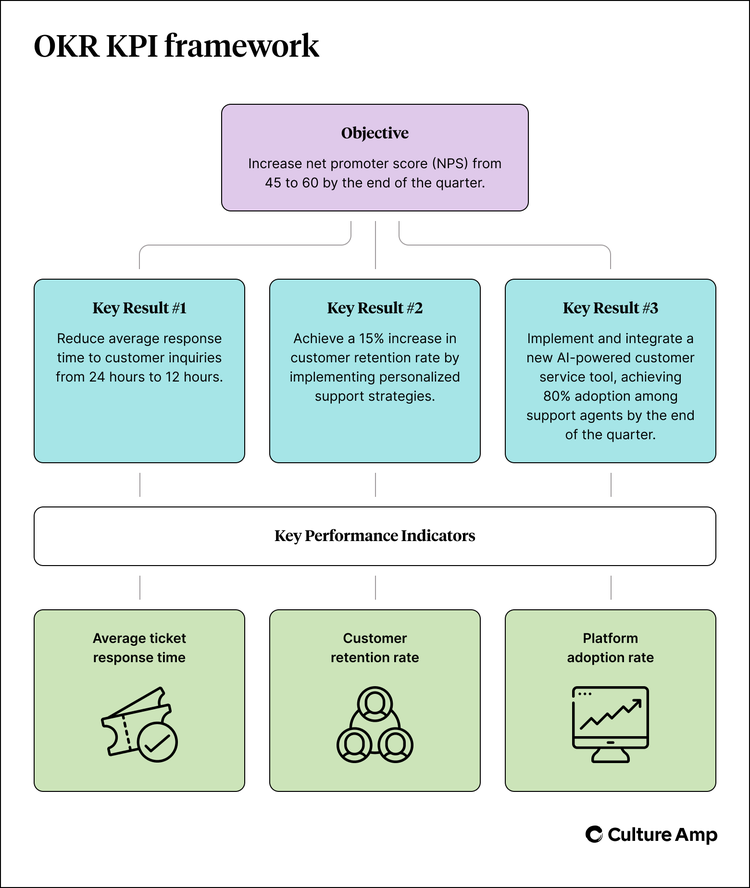
Decoding success metrics: Understanding OKRs vs KPIs

Information fuels success. Understanding your business’s current position and envisioning the path ahead are essential to strategic decision-making and sustained growth. Your organization can use objective and key results (OKRs) and key performance indicators (KPIs) to make the most of this information. With this goal-setting framework and the relevant performance metrics, businesses can harness the power of data and empower employees to move faster and achieve more.
To benefit from OKRs and KPIs, you must first understand them. To help, we’ve created a complete guide to OKRs and KPIs that covers what they are, how they differ, and how to use them together to unlock business success. We’ll also share a few best practices to show you how your current business performance can inform your future objectives.
What is an OKR?
Objectives and key results, or OKRs, are a goal-setting framework consisting of one overarching objective and two to five key results that measure your progress toward the objective. They’re particularly useful for breaking down large targets into more measurable goals.
What do OKRs look like in action? Here’s an example of a quarterly OKR for a customer success department:
- Objective: Increase net promoter score (NPS) from 45 to 60 by the end of the quarter.
-
Key results:
- Reduce average response time to customer inquiries from 24 hours to 12 hours.
- Achieve a 15% increase in customer retention rate by implementing personalized support strategies.
- Implement and integrate a new AI-powered customer service tool, achieving 80% adoption among support agents by the end of the quarter.
OKRs are also well suited for cascading goals. Businesses can use OKRs to take a top-down approach to goal-setting, ensuring organizational alignment and efficiency, while helping employees understand how their output impacts larger business objectives.
What is a KPI?
Key performance indicators, or KPIs, are metrics your organization uses to monitor and report on performance. These quantitative measures can help your company understand how you’re progressing towards goals, knowledge that empowers leadership to make data-driven and strategic business decisions.
There are two kinds of KPIs: leading KPIs and lagging KPIs. Here’s how they differ:
- Leading KPIs: Leading KPIs anticipate how your business may perform in the future. Examples include projected sales performance, customer engagement metrics, and website traffic.
- Lagging KPIs: Lagging KPIs track past performance, like employee turnover rate, number of workplace safety incidents, or profit margins.
Leading KPIs can help your business forecast performance, identify trends, and make strategic plans for the future, while lagging indicators give you context into how your company performed in the past, confirm trends, and affirm that your strategies are working.
Here are a few examples of department-specific KPIs:
| Sales | Marketing |
|
|
|---|---|
| Customer service | Finance |
|
|
|
| Human Resources | Operations |
|
|
|
OKR vs KPI: How do these terms differ?
While related, OKRs and KPIs are very different. OKRs are future-focused goals designed to drive change and organizational success, while KPIs are quantitative metrics that reflect current business performance. While they can work together, OKRs and KPIs have distinct purposes and focuses.
To help you better understand these differences, here’s a side-by-side comparison:
| OKRs | KPIs | |
|---|---|---|
| What are they? | Driving change and organizational success with goal-setting | Using key metrics to report current business performance |
| Main focus | Outcome | Output |
| Purpose | To align and focus employees on business priorities to achieve specific objectives | To measure and manage business performance |
| Time period | Focuses on the future | Measures the past or predicts future results |
| Lifespan | Set quarterly | Referenced year-round |
OKRs and KPIs: Better together
You don’t have to choose between using OKRs or KPIs in your business. Since they serve different purposes, you can use both to further your business goals. In fact, KPIs can inform and become an integral part of your OKRs.
Falling behind on a specific KPI target? Set up an OKR to help boost your metrics. Or, want to improve a specific KPI? OKRs can help you reach that next level.
By using OKRs and KPIs together, your business can create a powerful framework that combines strategic goal-setting with ongoing performance measurement. This framework will typically include three criteria:
- Your objective, or what you’re trying to achieve
- Your key results, or how you plan to reach your objective
- Your key performance indicators, or how you’ll evaluate how successful you were in accomplishing your key results
Using our earlier OKR example, here’s what this framework would look like in practice:

While many key results align with KPIs, not all of them can be directly tied to measurable metrics – and that's perfectly acceptable. Certain key results, like “Hire three new salespeople” or “Implement a new marketing software,” are action-based and don’t use KPIs to evaluate success. While tying key results to specific KPIs can help you understand and track ongoing performance, not every key result will require a KPI.
OKR and KPI examples
Still curious how to use KPIs to enhance your OKRs? Here are a few examples to help you visualize and understand the connections between these two performance metric frameworks:
OKR/KPI example 1: Improving brand visibility
-
Objective: Improve brand visibility and engagement
-
Key result 1: Increase website traffic by 30% compared to the previous quarter.
- Key performance indicator 1: Website traffic
-
Key result 2: Grow email subscriber list by 20% within six months.
- Key performance indicator 2: Number of email subscribers
-
Key result 3: Attain a click-through rate of 5% for the new brand awareness ad campaign.
- Key performance indicator 3: Campaign click-through rate
-
Key result 1: Increase website traffic by 30% compared to the previous quarter.
OKR/KPI example 2: Boosting sales
-
Objective: Increase sales revenue
-
Key result 1: Achieve a 20% increase in monthly sales compared to the previous year.
- Key performance indicator 1: Monthly sales revenue
-
Key result 2: Attain a conversion rate of 10% for website visitors to paying customers by the end of the quarter.
- Key performance indicator 2: Website conversion rate
-
Key result 3: Increase average order value by 15% through upselling and cross-selling strategies.
- Key performance indicator 3: Average order value
-
Key result 1: Achieve a 20% increase in monthly sales compared to the previous year.
OKR best practices
Here are a few things to keep in mind when establishing your quarterly objectives and key results:
1. Set SMART, attainable goals
Vague goals can leave employees confused and unmotivated. To avoid this, create OKRs that meet the five parameters set forth in the SMART goal-setting framework. Make them specific, measurable, ambitious, relevant, and time-bound. This gives your employees a clear understanding of what they need to achieve to meet or exceed a particular objective, which also helps foster a transparent, motivating performance management process.
Of course, goals are meant to push your employees, so make sure your OKRs are appropriately ambitious. Goals that are too easy or too difficult to reach may demotivate employees and negatively impact morale. You’ll want to find that sweet spot that stretches employees but doesn’t leave them drained.
2. Align goals throughout your organization
One strength of the OKR framework is that it easily cascades throughout a business. Organizational goals shape department goals which shape team and individual objectives. Keep higher-level goals in mind when setting goals at the department, team, and individual levels. This alignment will help employees understand how their contributions directly impact business success.
3. Revisit goals regularly
OKRs aren’t a set-it-and-forget-it approach to goals. They require frequent check-ins to monitor progress, address roadblocks, and readjust targets as needed. Using a goal management tool like Culture Amp helps keep OKRs at the top of mind and makes creating, tracking, and updating goals easy for everyone in your organization.
KPI best practices
Ready to use KPIs? To get the most out of these key business metrics, incorporate the following best practices:
1. Use benchmarks
Internal and external benchmarks can give additional context to your metrics and help your teams understand whether you’re trending ahead of or behind your past performance and competitors. By comparing metrics year over year, month over month, and even week over week, your business will better understand how business changes – as well as outside factors, like seasonality – are impacting your overall success. Equipped with this information, your teams can adjust their strategy to maintain or improve key metrics.
2. Regularly monitor KPIs
Establish an ongoing cadence for reviewing your KPIs and discussing performance across teams. Should your teams see any abnormal dips or surges in performance, they can proactively investigate the cause and work to improve or maintain these results. This allows your business to become more agile and gives your employees time to adjust to changing business needs or market conditions.
3. Keep KPIs focused
Be discerning about what metrics you choose to track. Having too many KPIs can confuse and overwhelm employees. Determine which KPIs are most relevant to the success of your key results and keep the list small and manageable. This will help your teams reflect on performance in one particular area of your business.
Creating effective OKRs and KPIs with Culture Amp
No matter what performance metric framework your business uses, your goals will only be effective if your employees can easily reference, track, and report on them. Too often, goals are set at the beginning of the quarter or year and then abandoned until the next review cycle. With a goal-setting software like Culture Amp, goals and OKRs can remain top of mind year-round and keep your teams working towards your highest business priorities.
With greater transparency around company goals, your business can help employees collaborate more seamlessly, make more informed decisions, and find their sense of purpose in your organization.

Learn more about Culture Amp’s goal-setting tool
Schedule a demo to see how Culture Amp can help you drive higher performance and business success.





